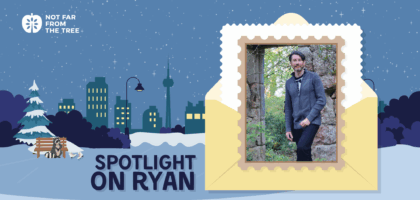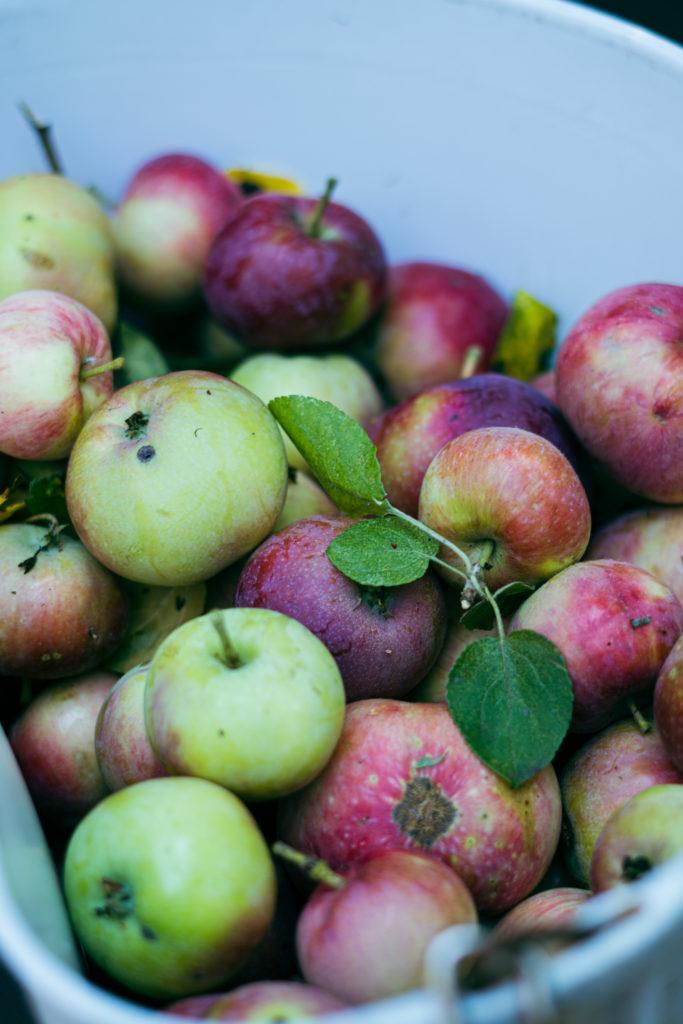
One cherry pick led Ryan to sharing over a decade with NFFTT
Despite Toronto’s dense population and seemingly endless slabs of concrete, we are nestled amidst a truly astounding urban orchard, boasting approximately 1.5 million pounds of fruit produced each year. Each time I tell someone about the work of Not Far From The Tree, people are shocked to hear how much fruit has been growing above their heads this whole time!
While our pick team is highly capable and dedicated to the cause of reducing food waste, the harsh reality is that the majority of that 1.5 million pounds cannot reasonably be captured by our program alone. In 2016, our most prolific year, Not Far From The Tree diverted 37,014 lbs of fruit from going to waste. That’s only 2.5% of the estimated available urban harvest that we were able to collect. Data on the topic of urban orchard food waste in Toronto is sparse: there is SO much fruit out there, but we have no accurate way of knowing how much falls to waste vs. how much gets “rescued” (i.e., picked and eaten by the tree owner or shared with the community) each year.
Many of us are familiar with the topic of food waste. In our day-to-day lives, we tend to think about discarded food like after dinner leftovers or throwing out groceries we didn’t get around to eating in time. If we think about food in a circular economy (from food production, to distribution, to consumption, to waste collection and processing, to reintegration and new uses), there are many opportunities to reduce waste, recover resources, and prevent unnecessary greenhouse gas emissions. At Not Far From The Tree, our mission is to avoid food waste and reduce emissions at the beginning of this cycle, by rescuing edible food that would otherwise fall from the tree, rot, and emit methane gases in the natural decomposition process or in the landfill.
Many tree owners feel their abundant fruit tree is a burden rather than a blessing. For example, between long shifts at work and caring for their family, they don’t have the time or resources to harvest a whole 400+ pound yielding apple tree on their property. 400 pounds of fruit will *quickly* become rotting fruit, which in turn attracts hoards of stinging insects and flies, maybe some critters as well. The sidewalk mess and undesirable pests leads their neighbours to call by-law. City employees arrive and suggest that, if the tree owner cannot manage their tree’s fruit, they should have the tree removed. The severity of the situation suddenly shifts from the avoidable issue of surplus food due to a lack of capacity, to a community safety concern and a devastating loss to our urban orchard.
At Not Far From The Tree, we aim to reconcile this awkward wasted food dynamic, by intervening before the fruit falls to the ground. Together, we have a power – a power to transform a forgotten, a surplus, or an undervalued fruit into an ingredient or a meal, all while significantly reducing food waste and methane emissions.

Additionally, many city dwellers have developed a slight distrust of any food that isn’t sold to us by a grocer, which is an issue that Helena Moncrieff discusses in her book, The Fruitful City: “we have lost touch with what grows naturally in our cities. Rather than figuring out what the fruit is and understanding if it is safe to eat, we opt to avoid it altogether ‘just in case.'” She calls this phenomenon ‘food illiteracy’. In grocery stores, many fruits and vegetables don’t even make it onto store shelves because they’re not pretty enough for consumers. To help prevent food waste during the fruit pick, we also collect what the industry refers to as ‘windfall’ – fruit that falls during the pick. While we only provide our tree registrants and service agencies with the cream of the crop, our volunteers have the opportunity to take home some of the slightly bruised, less-than-perfect produce for use in their home kitchens (we always recommended to give the windfall fruit an extra good cleanse before eating).
At NFFTT, we believe in providing fruit and tree education in order to reintroduce or reorient Torontonians to the cherries, apples, grapes, and pears that grow all around us in the ‘wild’. We’re passionate about supporting our network of social service agencies through the provision of fresh local fruit, as well as offering nutrition-focused, hands-on, skill-building workshops for their clients! You can read about our past workshops here, here, and here.
Each year, we are capable of rescuing thousands of pounds of fruit from going to waste. This translates into:
Fruit is a valuable natural resource that is too good to waste. So let’s use these powers of ours – let’s feed people! By harnessing the plentitude of our city’s fruit trees, we can foster healthy, resilient, sustainable and connected communities across Toronto.
“When edible food is redirected to food rescue organizations for distribution it maintains its highest value and security is improved for those that need it most: social service agencies, like meal programs, children’s breakfast programs, community centres, drop-in centres, summer camps, and women’s / homeless shelters.” – Recycling Council of Ontario
For at-home food waste reduction tips, check out David Suzuki’s Queen of Green resources, available here.
Check out the work of these local food rescue organizations, start-ups, and businesses:

One cherry pick led Ryan to sharing over a decade with NFFTT

Maddie’s love for NFFTT’s model of shared abundance